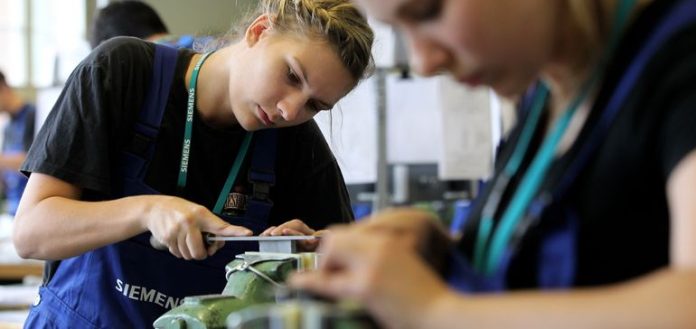Apprenticeship programs are a growing focus in the U.S. These offer students a different path than college, helping to engage those who may not be interested in furthering their academic interests. Apprenticeships can also help to boost pupils’ future earning potential and encourage them to remain in school.
“There are data showing that getting involved in-depth in career and technical education — what we used to call vocational education — does increase the likelihood of school completion,” Lerman said.
Apprenticeship programs differ from internships, which aren’t always paid. Students earn a stipend, sometimes hourly, as they learn new skills and tools specific to the workplace. These opportunities are more common across Europe, with fewer in the U.S., Lerman said.
However, some states, including Wisconsin and Georgia, have more robust high school apprenticeships. For example, The Apprentice School in Newport News, Virginia, which trains students in shipbuilding techniques and other disciplines, is so successful that the century-old program recently had 4,000 applications for 600 spots, Lerman said.
New York City has recently launched an apprenticeship program that will offer 3,000 students from 59 of the city’s more than 400 public high schools a chance to work as apprentices during their junior or senior year, Chalkbeat reports. They will earn up to $25 an hour for 15 to 20 hours a week, working with companies including Amazon, MasterCard, JPMorgan, and even the Brooklyn Navy Yard.
Lerman said the Urban Institute has funding from the U.S. Department of Labor to explore how to build more apprenticeship programs in the country. He believes the U.S. has leaned heavily on academics rather than trade learning in school, and that offering more options to students may help combat dropouts, even at the community college level. But he cautions that a robust program requires an investment of resources and time.
“It’s more complicated than adding a few classes,” he said. “You don’t have an apprenticeship without having an employer with a job. Helping them start a program is a genuine task. But it can be done.”
Get the free daily newsletter read by industry experts
COVID-19 likely increased homelessness, but different definitions of 'homeless' continue making it difficult for districts to help families access resources.
The rapid spread of classroom censorship policies has left educators feeling targeted and students without resources.
Subscribe to K-12 Dive for top news, trends & analysis
Get the free daily newsletter read by industry experts
COVID-19 likely increased homelessness, but different definitions of 'homeless' continue making it difficult for districts to help families access resources.
The rapid spread of classroom censorship policies has left educators feeling targeted and students without resources.
The free newsletter covering the top industry headlines






